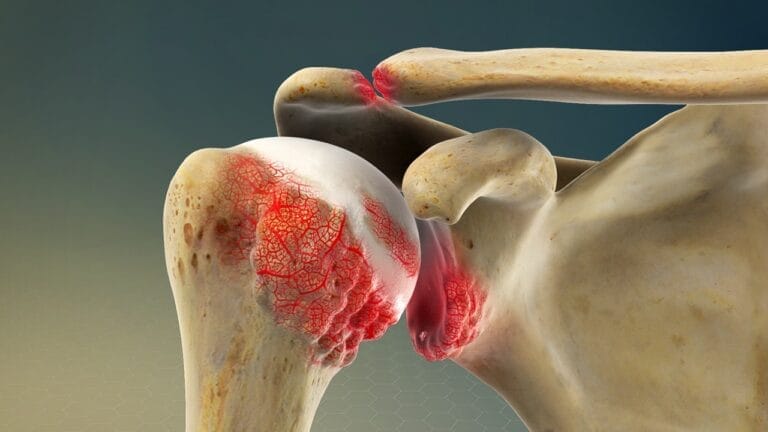Once shoulder arthritis is diagnosed, it necessitates proper treatment. While surgery may not always be necessary, it can be the sole solution in certain cases.
In this final article of his series on shoulder arthritis, distinguished consultant orthopaedic surgeon Professor Mohamed Imam sheds light on what individuals can anticipate during the treatment of shoulder arthritis.
Shoulder arthritis is a common condition that affects the joint, the primary joint of the shoulder. This joint is formed by articulating the ball-shaped end of the upper arm bone (humerus) with the shallow socket of the shoulder blade (scapula).
Like other forms of arthritis, shoulder arthritis involves the degeneration of cartilage, the smooth tissue that covers the ends of bones and facilitates smooth movement within the joint.
As the cartilage wears away, the bones can rub against each other, causing pain, stiffness, and loss of mobility in the shoulder.
Shoulder arthritis can develop due to various factors, including ageing, previous injuries, overuse, and genetic predispositions. It often progresses gradually, with symptoms worsening as the condition advances.
Individuals with shoulder arthritis may experience discomfort, swelling, and difficulty performing daily activities that require shoulder movement.
As the condition progresses, these symptoms can become more pronounced, impacting the quality of life and overall shoulder function.
While shoulder arthritis cannot be cured, several treatment options are available to help manage symptoms and improve joint function.
These may include medications, physiotherapy, lifestyle modifications, and, in severe cases, surgical intervention such as joint replacement surgery.
What causes shoulder arthritis and how does it affect susceptibility?
Understanding Shoulder Arthritis Triggers
- Ageing:Like other forms of arthritis, shoulder arthritis commonly occurs due to natural wear and tear on the joint over time. As people age, the cartilage that cushions the bones in the shoulder joint can gradually deteriorate, leading to arthritis.
- Previous Injuries:Previous injuries or trauma to the shoulder joint, like fractures or dislocations, can increase the risk of developing arthritis later in life. These injuries may damage the cartilage and surrounding structures, accelerating the degenerative process.
- Overuse or Repetitive Motion: Engaging in activities or occupations that include repetitive overhead movements or heavy lifting can strain the shoulder joint and contribute to the development of arthritis over time. Athletes, manual labourers, and individuals with physically demanding jobs may be more susceptible to shoulder arthritis due to these factors
- Genetics: Genetic factors could also play a role in predisposing individuals to shoulder arthritis. Certain genetic traits or conditions may affect the structure and integrity of the shoulder joint, increasing the likelihood of developing arthritis.
The impact of shoulder arthritis on susceptibility varies from person to person and can depend on a combination of factors like age, genetics, lifestyle, and previous injuries. While ageing is a common risk factor for shoulder arthritis, individuals with a history of shoulder injuries or those engaged in repetitive shoulder movements may be at a higher risk. Additionally, genetic predispositions can influence an individual’s susceptibility to developing arthritis in the shoulder joint.
2.What are the symptoms of shoulder arthritis and why is early recognition crucial?
Symptoms of shoulder arthritis typically develop gradually and worsen over time. Common signs and symptoms include:
- Persistent Shoulder Pain: Individuals with shoulder arthritis often experience persistent pain in the shoulder joint, which may worsen with movement or activity. The pain may be dull and also aching, or sharp, and it can interfere with daily activities and sleep.
- Limited Range of Motion: As arthritis progresses, individuals may notice a gradual loss of shoulder mobility and flexibility. They may find it challenging to raise their arm overhead, reach behind their back, or perform other tasks requiring shoulder movement.
- Stiffness and Tenderness: The affected shoulder joint may feel stiff, especially in the morning or after periods of inactivity. Tenderness and swelling around the joint may also be present, particularly during flare-ups of arthritis symptoms.
- Crepitus :refers to a grinding, popping, or crackling sensation within the shoulder joint when moving the arm. This can occur due to the roughening of the joint surfaces as the cartilage wears away, leading to bone-on-bone contact.
- Muscle Weakness: Chronic pain and also limited mobility causes weakness in the muscles surrounding the shoulder joint. As a result, individuals may experience difficulty performing tasks that require arm strength and stability.
Early diagnosis and intervention prevent joint damage and preserve shoulder function.
Shoulder arthritis often progresses through stages. Initially, the cartilage becomes soft (A), followed by the development of surface cracks (B). Subsequently, it starts to deteriorate and flake, a process known as fibrillation (C), ultimately leading to the wearing away of cartilage,
exposing the underlying bone (D). Consequently, the smooth, gliding function of the joint is compromised.
Early recognition of shoulder arthritis is crucial for several reasons:
- Timely Treatment: Identifying arthritis in its early stages allows for prompt initiation of treatment, which can help alleviate symptoms, preserve joint function, and slow the progression of the disease.
- Preventing Complications: Without early intervention, shoulder arthritis can lead to complications such as joint deformity, muscle atrophy, and decreased quality of life. Early recognition and management can help prevent these complications from occurring.
- Improved Outcomes: Studies have shown that early intervention in arthritis management leads to better treatment outcomes and higher success rates. By addressing symptoms early on, individuals have a greater chance of maintaining functional independence and overall well-being.
- Enhanced Quality of Life: Managing shoulder arthritis early can help individuals maintain an active lifestyle, participate in daily activities with less pain and less discomfort, and enjoy a better quality of life overall.
3.What are the best treatment options for shoulder arthritis and how can individuals decide on their care?
Shoulder arthritis significantly impacts daily life, but numerous treatment choices are available to address symptoms and enhance functionality. When contemplating treatment for shoulder arthritis, individuals must collaborate with their healthcare provider to identify the most appropriate approach tailored to their needs and preferences.
Non-Surgical Interventions:
Physiotherapy: A structured exercise regimen crafted by a physical therapist can enhance range of motion, bolster muscles surrounding the shoulder joint, and mitigate discomfort.
Medications: Over-the-counter pain medications like acetaminophen or nonsteroidal anti-inflammatory drugs (NSAIDs) can aid in reducing inflammation and alleviating pain. Occasionally, corticosteroid injections may be suggested for temporary relief.
Lifestyle Adjustments: Modifying daily activities and removing repetitive movements exacerbating symptoms can effectively manage shoulder arthritis. Employing assistive devices or ergonomic aids may also prove beneficial.
Surgical Alternatives:
Arthroscopic Surgery: This minimally invasive procedure entails employing small incisions and a miniature camera to visualise and address damage within the shoulder joint. Arthroscopic techniques might involve removing damaged tissue, repairing torn ligaments, or extracting loose bodies.
Joint Replacement: In cases of severe shoulder arthritis where conservative treatments fail to yield results, joint replacement surgery may be recommended. This procedure involves substituting the damaged joint surfaces with artificial components to alleviate pain and enhance function.
Alternative Therapies:
Acupuncture: Some individuals find relief from shoulder arthritis pain through acupuncture, a practice that involves the insertion of thin needles into the body points to encourage healing and alleviate discomfort.
Heat and Cold Therapy: Applying heat or cold packs to the affected shoulder can help diminish inflammation and soothe achy muscles. Alternating between heat and cold therapy may offer additional relief.
Exercises for Relieving Arthritis Pain in the Shoulder
4.How can individuals manage shoulder arthritis symptoms and enhance their quality of life?
Managing shoulder arthritis symptoms and improving quality of life involves a multifaceted approach incorporating various strategies tailored to individual needs.
Here are some innovative ways individuals can effectively manage shoulder arthritis:
- Stay Active with Gentle Exercise: Engage in low-impact exercises that promote joint flexibility and muscle strength without exacerbating pain. Activities like swimming, tai chi, and gentle yoga can help maintain mobility and reduce stiffness in the shoulder joint.
- Optimise Ergonomics: Modify your environment and daily activities to reduce the strain on your shoulders. Use ergonomic tools and equipment, adjust workstation setups, and practise proper body mechanics to minimise unnecessary stress on the joints.
- Explore Alternative Therapies: Consider complementary treatments such as acupuncture, massage therapy, and chiropractic care to alleviate pain and improve overall well-being. These holistic approaches can complement conventional therapies and relieve shoulder arthritis symptoms.
- Maintain a Healthy Lifestyle: Adopting a balanced diet rich in anti-inflammatory foods, staying hydrated, and getting adequate sleep can help support joint health and manage inflammation associated with arthritis. Maintain a healthy weight, reduce pressure on the shoulders and alleviate discomfort.
- Utilise Assistive Devices: Explore using assistive and adaptive aids to assist with daily activities and reduce shoulder strain. Tools such as ergonomic keyboards, reachers, and jar openers can make performing tasks easier and minimise joint stress.
- Practice Stress Management Techniques: Chronic pain and arthritis-related symptoms affect mental well-being. Incorporate stress-reduction techniques like meditation and deep breathing exercises, and mindfulness practices for relaxation and improve coping skills.
By implementing these innovative strategies and adopting a proactive approach to managing shoulder arthritis, individuals can enhance their quality of life and maintain optimal functionality despite the challenges posed by this condition.








